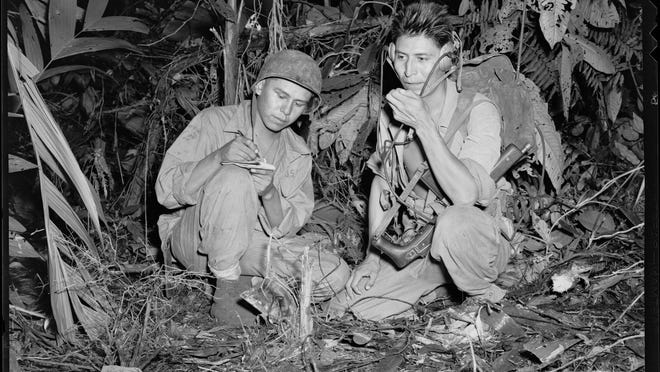One of the last remaining Navajo Code Talkers in the United States, Samuel Sandoval, has died. He was 98.
During World War II, Sandoval was a Navajo Code Talker who transmitted messages using his native language. He died late Friday at a hospital in Shiprock, New Mexico, his wife, Malula told The Associated Press on Saturday.
‘Toughest outfit in the world’: Sandoval chose the Marines
On March 26, 1943, Sandoval enlisted in the United State Marine Corps at a recruitment office in Farmington, New Mexico at the age of 18.
“The Marine Corps was my choice, to begin with,” he told The Arizona Republic in a 2019 article, and it was thanks to the influence of Marines he encountered while working in Hawthorne, Nevada, with his father in November 1942.
While working construction for the Department of Defense in the area, Sandoval said there were two units of military personnel, the Navy and the Marine Corps, stationed on-site. None were Navajo.
“I would become companions with some of the Marines stationed (there),” he said.
He recalls them asking him one day why he wasn’t joining the Marines. Sandoval didn’t ask them why he should join. He already knew what their answer would be: It’s the “toughest outfit in the world.”
That interaction stuck with him, and about a month later, Sandoval said he told his dad that he wanted to go home to Nageezi, New Mexico, to enlist in the military.
Once Sandoval completed basic training, he said the group was transferred to advanced training at Camp Pendleton in Oceanside, California.
“We went into the big barracks not knowing what we’re getting into,” Sandoval recalled.
Inside, Sandoval said they saw Navajos sitting at tables and desks.
They were the first 29 Code Talkers, recruited by the United States Marines in 1942, Sandoval said. They were responsible for helping develop the unbreakable code used across the Pacific during World War II.
“We asked them what they were doing,” Sandoval said. “They said, ‘We’re making a Navajo code.'”
The Code Talkers sent thousands of messages on Japanese troop movements and battlefield tactics in the Pacific. The code, based on the then-unwritten Navajo language, stumped Japanese military cryptologists and was crucial in helping the U.S. win the war.
Sandoval was on Okinawa when he got word from another Navajo Code Talker that the Japanese had surrendered and relayed the message to higher-ups, AP reported. He had a close call on the island, which brought back painful memories that he kept to himself, Malula Sandoval said.
He was discharged from the military on Jan. 26, 1946.
Stories about Sandoval’s experience as a Navajo Code Talker in the Marines are told in his book and a documentary about his life. Both are titled “Naz Bah Ei Bijei: The Heart of a Warrior.”
Returning home to the Navajo Nation
By 1943, Sandoval’s family lost most of their livestock as part of the fallout from the Navajo Livestock reduction program from the 1930s, which is when the U.S. government wanted to limit the amount of livestock Navajo people owned due to grazing on the Navajo Nation. The livestock were all killed as a result of the program.
Without livestock, Sandoval was at a crossroads. He could either go find work or go back to school; he chose school and used scholarships he received from his time in the service.
He studied surveying and went on to work for a surveying crew with a local oil company, according to Sandoval’s documentary. During this time, Sandoval was dealing with hardship caused by the mental and emotional wounds from the war.
Sandoval turned to alcohol as a way to cope, but that only led to other problems, the documentary states.
MORE: Money needed to build Navajo Code Talkers Museum, nonprofit tells NM lawmakers
WOUNDED KNEE ARTIFACTS: Return of Wounded Knee artifacts spotlights slow repatriation pace for Native Americans
One day in 1966, Sandoval felt a calling and wanted to help people in his community who struggled with substance abuse and addiction.
“I was determined to take the lessons learned from my own experiences and help people facing similar obstacles,” he said in the documentary.
He returned to college to earn a certificate in substance abuse counseling, and then worked in the Farmington area as a counselor. After years of working for other people, Sandoval ended up opening his own clinic in the late 1970s, a halfway house called To-Tah Alcohol Counseling.
The house served the Farmington area for more than a decade before it closed down when Sandoval retired in the early 1990s.
National Code Talkers to be honored August 14
In 1982, President Ronald Reagan declared August 14 as National Code Talkers Day. In 2000, the Honoring the Navajo Code Talkers Act was signed into law. By 2001, the Navajo Code Talkers were honored with Congressional Gold and Silver Medals. Sandoval received a silver medal.
No one in his family asked about Sandoval’s service. Sandoval said his father knew he was in the military, but couldn’t talk about it, so he didn’t.
Being raised traditionally on the Navajo Nation, Sandoval said the teachings he learned from his great-grandfather, who was a Navajo medicine man, included not to talk about “bad things like that.”
It wasn’t until he met his wife Malula that he started to open up more about his experience, and Malula has been documenting her husband’s stories.
She keeps journals of the stories her husband has shared with her, and she has photos and video throughout the years.
“What he shared with me, it’s in me, and I treasure that,” Malula said.
A GoFundMe account has been organized by the family to raise funds for funeral expenses.
In a tweet, Navajo Nation President Jonathan Nez said the life of Navajo Code Talker Samuel Sandoval is “remembered and honored by the Navajo People.”
Only three Navajo Code Talkers are still alive today: Peter MacDonald, John Kinsel Sr. and Thomas H. Begay.




